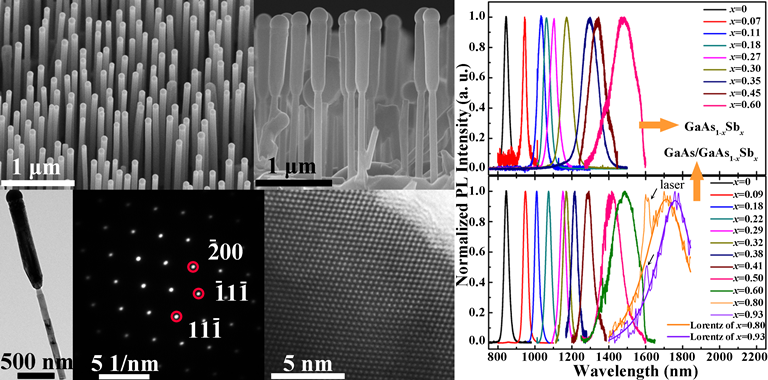Recently, a research team led by Prof. ZHAO Jianhua, at the State Key Laboratory of Superlattices and Microstructures, Institute of Semiconductors, Chinese Academy of Sciences, demonstrated their collaborative work on the successful growth of near full-composition-range high-quality GaAs1-xSbx nanowires by molecular-beam epitaxy.
As one of the most important narrow-bandgap ternary alloy semiconductors, GaAs1-xSbxhas a bandgap tunable over a large range from about 870 nm (GaAs) to 1720 nm (GaSb) at room temperature, which makes it an attractive material for band structure engineering and various optoelectronic applications, such as in optical fiber communication systems, infrared light-emitting diodes, photodetectors, lasers and heterojunction bipolar transistors. However, the fabrication of high-quality and high Sb content GaAs1-xSbxfilms remains a challenge because there is a large lattice mismatch between the GaAs1-xSbx films and III–V semiconductor substrates. Attributed to the ability to relax the elastic strain in the quasi-one-dimensional geometry, GaAs1-xSbx nanowires are promising to have high quality. Recently, several reports have been published on the growth of GaAs1-xSbx nanowires on Si substrates employing metal-organic chemical vapor deposition and molecular-beam epitaxy techniques, but almost all the reported GaAs1-xSbx nanowires have Sb content lower than 0.5. The controllable growth of large-composition-range high-quality GaAs1-xSbx nanowires is still difficult.
Through tuning the Sb and As fluxes, and the As background, Prof. ZHAO and her team, for the first time, have fabricated full-composition-range GaAs1-xSbx nanowires on Si substrate and GaAs stems using MBE. Transmission electron microscopy results confirm that the GaAs1-xSbx nanowires have pure zinc-blende crystal structure.
They collaborated with Prof. SUN Baoquan and Prof. TAN Pingheng at Institute of Semiconductors, and Prof. PAN Anlian at Hunan University to investigate the optical property of GaAs1-xSbx nanowires, and photoluminescence spectra confirm that the emission wavelength of the GaAs1-xSbx nanowires can be tuned from 844 nm (GaAs) to 1760 nm (GaAs0.07Sb0.93) at 77 K. The bandgap of the GaAs1-xSbx nanowires is tuned by 0.76 eV. Room-temperature Raman spectra confirm that optical phonons of the GaAs1-xSbx nanowires show red-shift with x increasing. Field-effect transistors based on individual GaAs1-xSbx nanowires show rectifying behavior in low Sb content devices, and but not in devices with high Sb content. The broad tunability of this antimony-based ternary alloy opens up new band-engineering opportunities for next-generation near-IR light emitting diodes, lasers, optical fiber communication, etc.
This work entitled with Near Full-Composition-Range High-Quality GaAs1-xSbxNanowires Grown by Molecular-Beam Epitaxy was published online in Nano Letters on Jan. 19, 2017. It was supported by the MOST of China (Nos. 2013CB922303, 2015CB921503 and 2016YFA0301200) and NSF of China (Nos. 61334006, 61504133, 61404127, 11225421, 11434010 and 11474277).

Fig.1 SEM and TEM images of near full-composition-range GaAs1-xSbx nanowires, and the PL spectra of GaAs1-xSbx nanowires at 77 K. (Image by Prof. ZHAO Jianhua et al.)
